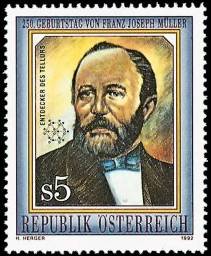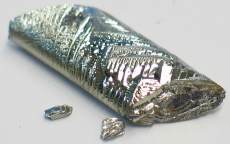Franz-Joseph Muller Freiherr von Reichenstein
July 1st 1740 (or October 4th 1742) - October 12th 1825
He discovered tellurium in 1782.

He discovered tellurium in 1782.

He was born on the July 1, 1740 Nagyszeben (now, Sibiu) Transylvania, or 4 October 1742 in Poysdorf, (Lower Austria), and died on the October 12, 1825 in Vienna.
He studied philosophy in Vienna but became a specialist in mineralogy.
In 1778 he discovered an occurrence of Tourmaline in the Zillertal.
In 1782 or 1783, as the main overseer of mines in Romania, he analyzed a bluish gold ore from Transylvania known as 'German Gold'. He extracted a metal believing it to be antimony. Soon he verified that it was an unknown chemical element, however did not continue the research in relation to this new element.
In 1798, the German chemist Martin Heinrich Klaproth isolated the new element and it called it Tellurium, but gave the credit of the discovery to the Franz-Joseph.
Another Source :
Baron Franz-Joseph Müller von Reichenstein (1742-1825) was born on Poysdorf, Niederösterreich (Lower Austria) on October 4, 1742. His 250th birthday was duly commemorated in 1992 by an Austrian stamp.
Incidentally, this serves to invalidate officially many reports that he would have been born instead on July 1, 1740 in Transylvania, at Nagyszeben (Hermannstadt).In Hungarian, Franz-Joseph Müller was known as Müller F. József. He became the main overseer of Transylvanian mines and took it upon himself to analyze a bluish gold ore known as German Gold. In 1782, he found that mineral to contain no antimony (121.76 g/mol) against previously accepted wisdom. Instead, he first suggested that the ore might be gold and bismuth sulphide. In 1783, however, he came to the firm conclusion that a new chemical element (127.6 g/mol) was involved, which he dubbed metallum problematicum [sic!]. Von Reichenstein then sent samples for confirmation to the University of Uppsala in Sweden, where the renowned Swedish chemist and mineralogist Torbern Bergman (1735-1784) died before he could complete the analysis...
Twelve years later, samples were forwarded to the German chemist Martin Heinrich Klaproth (1743-1817) who confirmed isolation of a new element before the Academy of Sciences of Berlin, on January 25, 1798. Klaproth started to investigate the chemical properties of that new element, which he called Tellurium, and gave Müller von Reichenstein full credit for the discovery. He did not mention the Hungarian chemist Paul Kitaibel (1757-1817), who had discovered the new element independently in 1789 and had handed over his report to Klaproth in 1796.
Tellurium (Te, Z=52) is actually a semiconductor chemically similar to Selenium (Se, Z=34) and radioactive Polonium (Po, Z=84). With Oxygen (O, Z=8) and Sulphur (S, Z=16) all those elements are in the same column of the periodic table and are collectively known as chalcogens.


Post a Comment for "Franz-Joseph Muller Freiherr von Reichenstein"